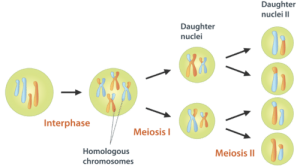How do cells multiply Sabrina Sharifzada
The Cell Cycle:
The cell cycle is what cells go through in order to create more cells. The cell cycle has 3 stages which are interphase, mitosis and cytokinesis.

Interphase:
This is the first and the longest stage in the cell cycle. In this stage the cell grows in size and replicates DNA.
Mitosis:
Mitosis is the second stage in the cell cycle where all the contents of the cells nucleus duplicate. Mitosis has four phases which are prophase, anaphase, metaphase and telophase (PMAT is a way to remember it). During prophase the nuclear membrane and the nucleolus disappears and the chromosomes join together into sister chromatids (joined by a centromere). In metaphase the sister chromatids line up the equator of the cell. In anaphase the spindle fibres pull the chromosomes to opposite ends of the poles. And the last step of Mitosis is when everything is replicated and is ready to become into two cells.

Cytokinesis:
The cell divides into to two separate cells with the same exact DNA.
Meiosis:
Meiosis is pretty much the same thing as Mitosis but it is PMAT x2 as well as this needs two parents unlike mitosis which needs one. Instead of making regular skin cells the process of Meiosis creates sperm and egg cells. The other difference is that in when a cell goes through mitosis it creates two cells by the end of Cytokinesis but in Meiosis it creates four sperm cells in the males body and one out of the four cells become an egg cell in a female, the other three are polar bodies and aren’t much of use. Just like mitosis, meiosis also has interphase. During interphase each of the homologous pair of chromosomes is replicated. Homologous meaning that they are matching chromosomes one from each set (mother and father). During the first round of PMAT which I will refer to as Meiosis 1, and then the homologous chromosomes separate into two cells . Then in Meiosis 2, the chromosomes don’t replicate but the sister chromatids end up separating and creating four cells. And in each cell that is created there is only 23 chromosomes.
Sexual Reproduction:
Sexual reproduction is when the sperm and the egg cell come together and the from a new organism such as a baby. There are three steps in sexual reproduction which are mating, fertilization and development. Mating is when gametes also known as sex cells come together at the same time at the same place. there are two ways of fertilization which are external and internal fertilization. Internal fertilization is when the sperm cell meets an egg cell inside the females body. Pollination is basically internal fertilization but for plants. Pollen is yellow and powdery and carries the plant male gamete to the female reproductive system and then the pollen tube transports the sperm cell to the egg cell. After that fertilization occurs and the zygote grows into an embryo and nourished with the food that exists in the seed. External fertilization is when the sperm and the egg cell meet outside the body of the parents. External fertilization mostly occurs in underwater species. The results of fertilization whether it’s internal or external, a zygote is created and contains 23 chromosomes from the mother and 23 chromosomes from the father. A zygote then goes thorough mitosis and cell division then and becomes an embryo. However for a zygote to go through cell division the following conditions nee to be met which are; there must be enough nutrients for the embryo is divide, the temperature has to be warm enough so the enzymes and proteins can function properly when they go through chemical reactions, there must a certain amount of moisture in the embryo so that it doesn’t dry out and lastly the embryo needs to be protected from ultraviolet radiation as well as predators. Embryonic development is the early development in their offspring and occurs after the first two months after fertilization. Then there is fetal development where there is three trimesters and each trimester is 3 months long. During the first trimester, the organs, the brain and the spinal cord develop and the embryo is then called a fetus. The second trimester the mother can feel the baby moving and weighs 650 grams. In the third trimester the fetus grows and prepares for birth, major growth in the brain and fat is produces under the skin of the fetus.
Asexual Reproduction:
Many organism naturally form clones through asexual reproduction. A clone is an identical genetic copy of its parent. Cloning is also used agriculture and research to copy desired organisms, tissue, and genes. In asexual reproduction there is only one parent needed. There are many types of asexual reproduction such as binary fission, budding, fragmentation, vegetative reproduction and spore formation. Binary fission is when single cell organisms split into two identical copies and some examples are amoeba and algae. Budding is when areas of multicellular organisms undergo repeated mitosis to form an identical organism and some examples of it are sponge and hydra. Fragmentation is when a part of an organism breaks off and the grows back with the clone of its parent and a example is starfish. Vegetative reproduction id when special cells in plants that develop in to structures that form into new plants identical to its parent and some example are strawberries and potatoes. Spore formation is when some bacteria, micro-organisms, and fungi can form spores – single cells that grow into a whole new organism and some examples are fungi, micro-organisms and some bacteria. There is two types of cloning which are human assisted cloning and also therapeutic cloning. The purpose of human assisted cloning is to create desired results with organisms. And the purpose of therapeutic cloning is to correct health problems.


